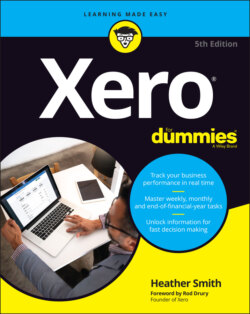Читать книгу Xero For Dummies - Heather Smith - Страница 34
Financial Settings
ОглавлениеFinancial information about the business that may affect reporting parameters can be defined in the Financial Settings dashboard. At the sign-up stage, you indicated where the business is registered to pay taxes (refer to the section ‘Getting started’, earlier in this chapter, for more).
Where your business is registered to pay tax affects the options available through the Financial Settings dashboard in Xero. If at all unsure, seek specialist advice for your own particular circumstances.
To access the Financial Settings dashboard, click on the organisation name in the top left of the screen and then select Settings from the drop-down list that appears. Click the link that says Looking for Advanced Settings? and select Financial settings.
The first field in the Financial Settings window is the Financial Year End. This date is the annual date that your business financial reports are prepared to. In many businesses, the financial year end aligns with the income tax year end for the country the business pays tax in. The business’s financial year end date is auto suggested, and can be changed if necessary.
Xero next asks you to choose the consumer tax options for your region (refer to Table 2-1 for the options that may apply). If in any doubt about how to complete this section, check with your accountant or Xero Adviser.
The next block is the Tax Defaults for Sales and Purchases block. From the drop-down menu, you can choose from four options: Based on Last Sale, Tax Inclusive, Tax Exclusive, and No Tax.
If UK users fall under the Construction Industry Scheme, they need to indicate if they are a registered contractor and/or subcontractor. You then enter your Unique Taxpayer Reference (UTR), Accounts Office Reference, Employer’s PAYE Reference, and the Subcontractor Deduction Rate, depending on the options chosen. If at all unsure on this, refer to your Xero Adviser, because this can’t be disabled once activated. UK users also need to enter their BACS Service User Number/Owner ID if they create a file from Xero that banks use to facilitate bulk payments (otherwise known as batch payments; see Chapter 7 for more).
Lock dates prevent users from altering accounts prior to and inclusive of the set date. Xero has two lock date fields. Use the first lock date to lock down the previous period. Use the second lock date to lock down the previous financial year. To do this, go to the Period Lock Date drop-down menu, select the date, and click Save.
Once the first lock date has been set by an Adviser, only users with Adviser status in Xero can edit accounts prior to and inclusive of this date. The Xero Adviser can also change the period lock date if required. Once the second lock date has been set by an Adviser, no user can make changes up to and inclusive of the lock date. The Adviser can change either lock date.
The final field in the Financial Settings window is the Time Zone field, which you set up during the sign-up process. This should already be populated.
When you’re happy with the details you’ve entered, click the green Save button.
